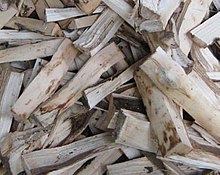
Back عود (خشب) Arabic Lapnisan BCL আগর কাঠ Bengali/Bangla Fusta d'agar Catalan Madera de agar Spanish چوب آگار Persian Calambac French Gaharu ID Agarwood Italian 沈香 Japanese

Agarwood, aloeswood, eaglewood, gharuwood or the Wood of Gods, most commonly referred to as oud or oudh (from Arabic: عود, romanized: ʿūd, pronounced [ʕuːd]), is a fragrant, dark and resinous wood used in incense, perfume, and small hand carvings. It forms in the heartwood of Aquilaria trees after they become infected with a type of Phaeoacremonium mold, P. parasitica. The tree defensively secretes a resin to combat the fungal infestation. Prior to becoming infected, the heartwood mostly lacks scent, and is relatively light and pale in colouration. However, as the infection advances and the tree produces its fragrant resin as a final option of defense, the heartwood becomes very dense, dark, and saturated with resin. This product is harvested, and most famously referred to in cosmetics under the scent names of oud, oodh or aguru; however, it is also called aloes (not to be confused with the succulent plant genus Aloe), agar (this name, as well, is not to be confused with the edible, algae-derived thickening agent agar agar), as well as gaharu or jinko. With thousands of years of known use, and valued across Muslim, Christian, and Hindu communities (among other religious groups), oud is prized in Middle Eastern and South Asian cultures for its distinctive fragrance, utilized in colognes, incense and perfumes.

One of the main reasons for the relative rarity and high cost of agarwood is the depletion of the wild resource.[1] Since 1995, the Convention on International Trade in Endangered Species of Wild Fauna and Flora has listed Aquilaria malaccensis (the primary source) in its Appendix II (potentially threatened species).[2] In 2004, all Aquilaria species were listed in Appendix II; however, a number of countries have outstanding reservations regarding that listing.[2]
The varying aromatic qualities of agarwood are influenced by the species, geographic location, its branch, trunk and root origin, length of time since infection, and methods of harvesting and processing.[3]
Agarwood is one of the most expensive woods in the world, along with African blackwood, sandalwood, pink ivory and ebony.[4][5] First-grade agarwood is one of the most expensive natural raw materials in the world,[6] with 2010 prices for superior pure material as high as US$100,000/kg, although in practice adulteration of the wood and oil is common, allowing for prices as low as US$100/kg.[7] A wide range of qualities and products come to market, varying in quality with geographical location, botanical species, the age of the specific tree, cultural deposition and the section of the tree where the piece of agarwood stems from.[8] As of 2013[update] the global market for agarwood had an estimated value of US$6 to 8 billion and was growing rapidly.[9]
- ^ Broad, S. (1995) "Agarwood harvesting in Vietnam" TRAFFIC Bulletin 15:96
- ^ a b CITES (25 April 2005) "Notification to the Parties" No. 2005/0025 Archived 30 September 2007 at the Wayback Machine. (PDF) . Retrieved on 22 July 2013.
- ^ López-Sampson, Arlene; Page, Tony (20 March 2018). "History of Use and Trade of Agarwood" (PDF). Economic Botany. 72: 107–129. doi:10.1007/s12231-018-9408-4. ISSN 0013-0001. S2CID 49875414.
- ^ "Top 10 Most Expensive Woods in the World". Salpoente Boutique. 18 November 2016. Retrieved 19 September 2020.
- ^ "11 Most Expensive Woods in the World". Ventured. 22 July 2020. Retrieved 19 September 2020.
- ^ Andy Ash (27 August 2020). "First-grade agarwood can cost as much as $100,000 per kilogram. Why is it so expensive?". Business Insider. Retrieved 17 September 2020.
- ^ Naef, Regula (March 2010). "The volatile and semi-volatile constituents of agarwood, the infected heartwood of Aquilaria species: a review". Flavour and Fragrance Journal. 26 (2): 73–87. doi:10.1002/ffj.2034.
- ^ Dinah Jung, The Value of Agarwood: Reflections upon its use and history in South Yemen, Universitätsbibliothel, Universität Heidelberg, 30 May 2011, (PDF) p. 4.
- ^ International Journal of Pharmaceutical and Life Sciences, Archived 16 April 2014 at the Wayback Machine ISSN 2305-0330, Volume 2, Issue 1: January 2013)